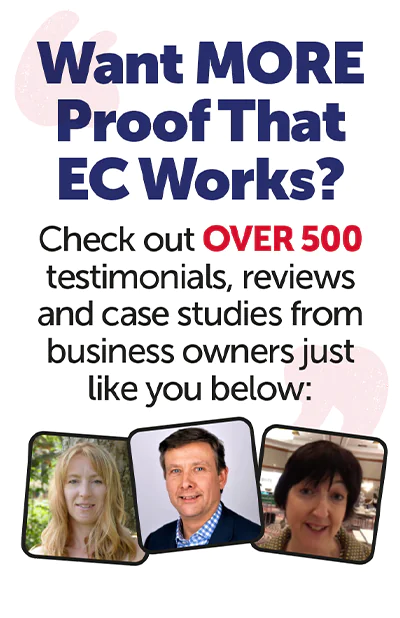It was during 2013 that I realised I had to do something.
My business, which provides support to Linux users across the UK, had been running for more than ten years, but I wasn’t happy. We’d always been profitable, but we were also stagnant.
I was frustrated: how was it that other businesses that started after mine were now bigger than me? What were they doing that I wasn’t?
Sometimes asking for help is the smart thing to do, and the EC’s Mastermind was an obvious choice – but not cheap. A little due diligence was called for. I cornered a few members that I knew were in Mastermind and asked their opinion. Had it helped? Would they recommend it? What was the downside?
Most were positive; one was neutral and one negative. Not so different from Amazon reviews, then, and if the majority give it five stars then it’s probably worth it. I joined Mastermind.
Merely joining Mastermind, however, will not achieve anything. For one of the first meetings, I took along the ideas we had for restructuring our IT support offerings. Lots of feedback, lots of ideas, lots of work to do – but from April 2014, we had three well-defined, clearly priced support offerings implemented, and a very effective way of presenting those options to clients.
One challenge we faced was providing 24hr support. We needed to offer it, but the problem was funding it: until a critical mass of clients signed up for it, it would be very expensive to pay staff to be on call. We had a staff meeting, we explained what we wanted to achieve and why it was important to the business, and we asked for their help. They gave it.
We recognised the value of staff reviews, but lacked a consistent and useful framework within which to conduct and measure them. More discussion at Mastermind, more ideas, more implementation. At each review now, the member of staff and their manager independently assess the employee in around 15 different areas, marking them from 1 to 6 on a clearly-defined scale. We saw a very good correlation between the manager’s and the employee’s assessment, making it much easier to discuss areas that need focus and providing support to the employees as required.
We find it very, very hard to recruit staff of the quality we want, and candidates often have unrealistic salary expectations. We introduced a technical self-assessment form that interviewees have to fill in, rating their skills in a number of key areas, both technical and non-technical, from 0 to 3. We give examples of the knowledge or experience required at each level. This has transformed our recruitment interviews: a candidate with a page full of zeros and ones realises that their value is lower than they might like. It also makes the interview easier to conduct as it’s clear which areas should be discussed.
We were growing; our processes were improving week on week (thank you EC and the 90 Minutes), but we wanted more growth.
There are moments in Mastermind when one’s comfort zone quietly slips out of the door, leaving one (metaphorically) naked in the room. I experienced one of those moments when it was suggested that we should employ a sales person. Quite why the idea of a business employing a sales-person should be so scary isn’t clear now, but I remember it very distinctly .
We took on a telesales/telemarketing person, and we all learnt a lot in the first couple of months. Our avatar was ripped apart and redefined; our target markets were scrutinised; the best approach to engaging with prospects was discussed at length. One of the issues we face as a business is identifying prospects.
We are looking for businesses that use Linux, a free operating system used by, for example, Wikipedia, Amazon and Google, but there’s no defined process for buying the software: anyone can legally download it for free. For us to be effective in selling top notch support and consultancy services to companies that use Linux, we needed to find a way of identifying them. With help from the EC, we worked out a way of doing that, and for the first time in the company’s history we now have a ‘Dream List’ of over 100 ideal prospects.
In October 2014, my wife and I went away for a planning weekend, as recommended by Nigel. To be honest, we weren’t sure how valuable it would be, but it was one of the most powerful things we have ever done for the business. We came back with a clarity that we had never previously had, both for our personal and business lives.
As a result, we set a target for the number of servers we wanted to have on support contracts by the end of 2015. The number was scary, and more than once I suspected I had set the wrong number. In a way I was right: by the end of August, we had exceeded it.
Clearly the number had been too low! We’d explained the target to our staff, and we put a big picture of the Eiffel Tower on the wall with the number of servers supported running up one side of the picture, and a big red arrow that slowly moved up as the year went on. As a result of the arrow now being stuck to the ceiling, the whole company is going to Paris for a long weekend in April, with partners, all expenses paid.
And the result?
For the business, a five-fold increase in rolling 12-month net profit from where we were two years ago.
For us, 2015 brought two, big holidays including one at Disney World, Florida; much nicer cars for my wife and me; and we’ve started down the road to knock down and rebuild our house. The business paid for all of it.
We’ve just returned from our second planning weekend with another, even scarier, number for 2016, and we can’t wait to get started. There’s been frustration, fear, even tears, but I wouldn’t change it.
It should be illegal to have this much fun.
Keith Edmunds – Tiger Computing


